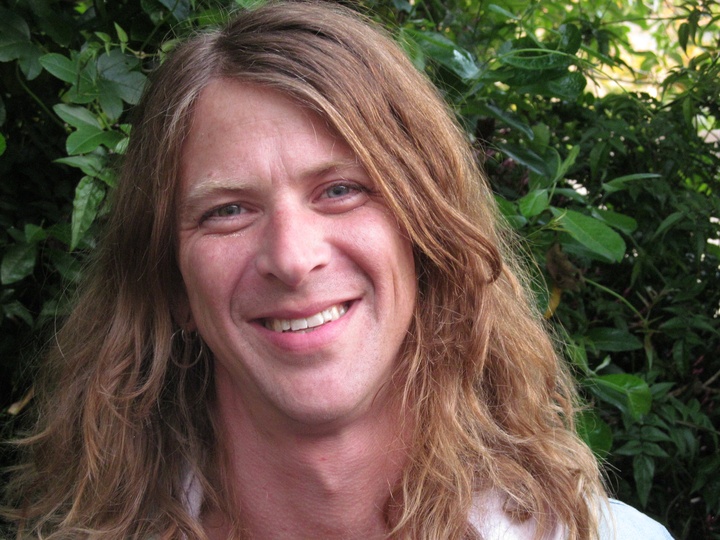
GENDER PIONEER: Andi Rostad amended a court form to become legally gender nonbinary.
Photo courtesy Andi Rostad.
###
SEE: EXPLAINER: On the Use of the Singular ‘They’
###
Andi Rostad defies categorization. On May 15, the 36-year-old said, they became the first resident of Humboldt County to be legally declared gender nonbinary. And if California Senate Bill 179, the Gender Recognition Act, passes, they will not be the last.
SB-179 is wending its way through the approval process. It was approved by the Senate May 31 and is now halfway to enactment, having to go through the State Assembly voting process.
People who define themselves as nonbinary identify neither as male or female, but rather as both or neither. Even prior to the enactment of the proposed law, a number of Californians – from San Diego to San Francisco – have appeared before the courts in recent months to legally change their gender to nonbinary. Sarah Kelly Keenan, an intersex resident of Santa Cruz, was the first person in California to be granted the status last September.
A NOTE ON TERMINOLOGY
- Sex: A person’s biological chromosomes, hormonal profiles, internal and external sex organs.
- Intersex: A person born with a reproductive or sexual anatomy that does not fit the typical definitions of female or male sex. About one percent of humans are intersex.
- Gender: The characteristics that a society or culture delineate as masculine or feminine.
- Nonbinary: A person with a gender identity that does not fit the masculine/feminine binary.
Tall and willowy, with long hair, multiple tattoos and piercings, Rostad wore glitter and ballerina flats to our interview. “You’ll never see me wearing something that came from the men’s department,” they pointed out. Rostad was raised male, but has been “fighting against the masculine/male box” that their body put them in and began identifying as gender nonbinary in March 2015. “I’m pushing as hard as I can in the feminine direction,” they said.
Rostad prefers to be addressed and spoken of with gender-neutral pronouns, though female or male pronouns are also acceptable. They understand that this may be difficult for some. “It’s a lot to ask,” they said, “but it’s not too much to ask.” Rostad tries “to keep love in their heart” when people get it wrong.
Rostad found out about nonbinary gender through internet searches as they were reaching a breaking point. “I couldn’t go on living as ‘a guy’,” they said, and had begun reading about other cultures with third genders, as well as two-spirit people in Native American societies. Whey Rostad read about Keenan’s gender change, and later met her (Keenan prefers female pronouns), they realized that there were options open to them.
Rostad at first legally changed their name in January 2016 to to Andi with an I, which “better reflects my nonbinary gender identity,” they said. Upon realizing that they could file for nonbinary gender, Rostad returned to the Humboldt County Courthouse to file for a gender change.
Currently, the State of California Petition for Change of Gender form only encompasses changes from male to female or from female to male. Undeterred, Rostad altered the form, adding a third box stating “from male to nonbinary” to the form and checking it off. The form was accepted by the court without comment when Rostad appeared before the judge. “It went great,” said Rostad, “it was a total nonevent.”
That form, and more, would have to be amended if SB-179, California’s Gender Recognition Act, passes. The law would recognize a third nonbinary gender on court orders, birth certificates and state ID, including drivers’ licenses. The law would also remove the requirement that persons requesting a gender change be under medical care, replacing the need for a doctor’s letter with an affidavit by the person requesting the gender change.
Until the law is enacted, however, Rostad’s legal ID, including their driver’s license, will continue to identify them as male, at odds with their gender expression and with their legal gender. If SB-179 passes, they would be able to obtain a license with a nonbinary designation of X, said Rostad. Nonbinary persons born in California would be able to have their birth certificates amended to reflect their nonbinary gender.
However, because Rostad was born in North Dakota, their birth certificate would not match the rest of their identity documents until and unless that state enacts a similar statute. Rostad has not ruled out taking the fight for nonbinary gender recognition to North Dakota. In that, Rostad would be fighting side-by-side with the Intersex & Genderqueer Recognition Project, an organization that works collaboratively with others, such as the Transgender Law Center, to address the rights of people to identify as nonbinary on government issued documents on a state-by-state basis.
While Rostad describes themselves as a very private, not terribly outgoing person, they have stepped forward in the hope of helping other people who may be seeking to have their gender identity confirmed. Obtaining the legal gender change “is an extremely discreet process and nothing to be intimidated about,” they said. To others questioning their gender or wanting to assert their nonbinary status, “It’s not just this crazy trip that you’re on by yourself,” said Rostad.
###
RESOURCES:
###
Lauraine Leblanc is scene editor of the Mad River Union. Subscribe here.

CLICK TO MANAGE